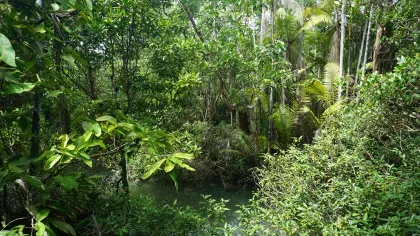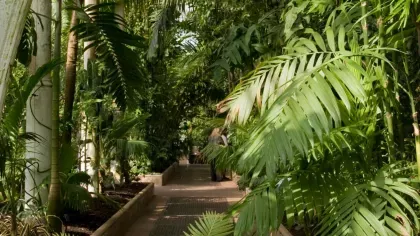More than cowslips: Primulaceae goes tropical
Our improved understanding of plant evolution has resulted in changes to many well-known families. Here, Tim Utteridge and Ruth Bone discuss their Primulaceae research, including the expansion of the family to include several tropical woody members.

Part I: Tropical primulas
Primulaceae are well known in the northern hemisphere, especially the spring flowers primrose (Primula vulgaris), cowslip (Primula veris), and oxlip (Primula elatior). These are not only charismatic wild flowers but important in horticulture, alongside several other genera including Androsace, Dodecatheon, Lysimachia, and of course Cyclamen.
Traditionally, Primulaceae contained only these temperate herbaceous groups, and was a family of around 20 genera and 900 species. It was known to be very closely related to Myrsinaceae (Judd et al. 1994) – a group of around 40 genera and 1,700 species – but was kept separate, primarily on account of Myrsinaceae being woody and tropical. However, better understanding of angiosperm evolution through the use of DNA evidence showed that these groups were very closely related. Rather than just being a problem of rank and of where to draw the line and delimit the family, there was the additional complication that DNA evidence placed several of the traditional Primulaceae within Myrsinaceae.
Both groups have a suite of similar morphological characters and it was clear that there was little point in keeping them as separate families. The enlarged Primulaceae now comprises around 60 genera and 2,700 species in four subfamilies:
- Maesoideae (1 genus/160 species)
- Theophrastoideae (6–9/105)
- Primuloideae (9/900)
- Myrsinoideae (40/1500)
The advantages of having this larger family are that it reflects evolutionary history and it is now easier for UK and temperate-based tropical botanists to convey to non-botanists in education, teaching etc. that these groups are related to plant names and concepts embedded in the western temperate botanical lexicon. The disadvantages are that the many tropical botanists who have learnt a unique tropical plant group have now had it subsumed into a ‘European’ garden plant group and lost the immediate clarity of using a single name for this group (that is ‘Myrsinaceae’ has become Primulaceae subfamily Myrsinoideae).
Asian Primulaceae research at Kew
Tropical Primulaceae form a species-rich but poorly known group that was last monographed in its entirety in 1902 (as Myrsinaceae, see Mez, 1902) and only regional treatments have been written since then. The SE Asia members form one of the groups studied by Kew’s Asia Team in the Identification & Naming department. Initially, the focus was on the genus Maesa - a group of small trees and scramblers – (for example Utteridge & Saunders, 2004), but more recently, as part of joint research with Malaysian collaborators, Kew has started to undertake a taxonomic revision of Primulaceae-Myrsinoideae in Peninsular Malaysia, commencing with the genera Ardisia (for example Julius & Utteridge, 2012) and Embelia (Dubéarnès et al., 2015).
In SE Asia, Primulaceae-Primuloideae are poorly represented, with only Primula (two species) and Lysimachia (eight species) native to the region, and, because of the temperate thermo-ecology, these are restricted to montane and alpine areas, mainly in the mountains of Sumatra and Java. In contrast, the Maesoideae and Myrsinoideae are species-rich groups with up to 500+ species, found in nearly all habitats except subalpine and alpine areas. Ecologically they inhabit a range of niches and this is reflected in diverse vegetative morphology (the flowers being quite similar in size and shape through the Myrsinoideae). In Borneo rainforests, for example, there are forest floor under-shrubs with decumbent stems barely reaching 1 m (Ardisia obovatifolia Merr.) to large trees in primary forest usually from 15–20 m but recorded as attaining 30 m and just reaching the forest canopy (Ardisia copelandii Mez).
Future prospects
Currently, work at Kew is aimed toward the taxonomy of the groups in combination with phylogenetic studies with collaborators to examine subgeneric groupings. The main areas are the revision of the genus Maesa in SE Asia; examining subgeneric groupings in SE Asia Ardisia; the phylogeny of Embelia; and the revision of Ardisia and satellite genera in SE Asia. The genus Maesa has been a neglected group that still lacks a robust subgeneric grouping and many poorly defined species limits that are only now being tackled with better collections and field observations (see Utteridge, 2014). These projects will help us to understand the taxonomy, evolution and diversification of the family to mirror our understanding of the temperate Primulaceae.
Part II: Island endemism in the Indian Ocean - recent evolution and 'ecological ruin'
In 2008, I was hanging from a pulley on a zip-wire between two mountain peaks in the south-west corner of Mauritius, with a camera, a backpack full of sampling equipment, my plant press and collector book. I was determined to reach one of the only surviving trees of Badula crassa in its precarious fragment of native dry forest on the side of Le Morne mountain, and collect samples for my research.
A handful of Badula species are found in Mauritius and Reunion to the west, and a single species (Badula balfouriana) has been described from Rodrigues, to the east. Badula therefore represents one of the few endemic genera that occurs throughout the young (<15 million year old; Myr) volcanic trio of islands that comprise the Indian Ocean’s Mascarene archipelago. I had encountered another of the Mauritian Badula species (B. reticulata) in a clearing among dense stands of invasive alien shrubs, where three of the five known plants stood. Spindly stems arched towards the dark forest floor with broad dark green leaves borne in clusters towards the tips. On one tree, a long pendulous inflorescence of pink flower buds hung down resembling a string of delicate pink coral. Less than half a mile away, in a Conservation Management Area of tropical Phillipia and Phylica heath, a few scattered plants of Badula platyphylla grew on the orange laterite soil, with knobbly-elbow branches and similar, but much thicker leaves to its forest neighbour and shorter, sturdier inflorescences.
Back in the lab, I extracted DNA from the carefully collected leaf samples of all Rodriguan and Mauritian Badula species and began to build a picture of the evolutionary histories of these plants through comparison of DNA sequences. Joeri Strijk, then based in Toulouse, had sampled some of the less clearly characterised species that grew in the upland forests of Reunion. Combining our data, we searched for genetic evidence for the species described in the taxonomic literature (Coode, 1976, 1979, 1981), and geographical patterns that might explain the origin of these curious plants.
Our research recovered evidence for genetic clustering of species that are endemic to single islands, suggesting that ancestral Badula became established through 'stepping-stone' dispersal leading to single/few colonisation events on each of the Mascarene islands, followed by speciation (Bone et al., 2012; Strijk et al., 2014). Molecular clock analyses suggested that this occurred in an east to west direction (Strijk et al., 2014), from older islands (Rodrigues/ Mauritius; 10/ 8 Myr) to the youngest (Reunion; 2 Myr). An absence of clear morphological distinction among some Reunion Badula species was reflected by unclear genetic relationships, suggesting that these taxa may be hybridising, or still undergoing speciation.
While the differing geological histories of the Mascarene islands have no doubt shaped the past evolutionary trajectories of Badula (and the Mascarene flora), the varying levels of anthropogenic habitat destruction and ‘ecological ruin’ among the islands (Cheke & Hume, 2008) dramatically alter the availability of habitats that can be occupied by its descendants (Bone et al., 2012). One cannot underestimate the effect of this changed environment on the evolutionary potential of these species when Badula crassa, like many Mascarene endemic taxa, survives only on isolated peaks.
References
Bone, R. E., Strijk, J. S., Fritsch, P. W., Buerki, S., Strasberg, D., Thebaud, C. & Hodkinson, T. H. (2012). Phylogenetic inference of Badula (Primulaceae), a rare and threatened genus endemic to the Mascarene Archipelago. Botanical Journal of the Linnean Society 169: 284–296. Available online
Cheke, A. & Hume, J. (2008). Lost Land of the Dodo: an Ecological History of Mauritius, Reunion and Rodrigues. London: T & AD Poyser.
Coode, M. J. E. (1976). Notes on Pittosporaceae and Myrsinaceae of the Mascarenes. Kew Bulletin 31: 221–225. Available online
Coode, M. J. E. (1979). Further notes on Myrsinaceae in the Mascarene Islands. Kew Bulletin 34: 413–416. Available online
Coode, M. J. E. (1981). Myrsinacées. In: Bosser J, Cadet T, Guého J, Marais W, eds. Flore des Mascareignes. Kew: MSIRI, ORSTROM & RBG, 115, 1–25.
Dubéarnès, A., Julius, A. & Utteridge, T. M. A. (2015). A synopsis of the genus Embelia in Peninsular Malaysia and Singapore. Studies in Malaysian Myrsinaceae III. Kew Bulletin 70: 25. Available online
Judd, W. S., Sanders, R. W. & Donoghue, M. J. (1994). Angiosperm family pairs: preliminary phylogenetic analyses. Harvard Papers in Botany 1: 1–51.
Julius, A. & Utteridge, T. M. A. (2012). Revision of Ardisia subgenus Bladhia in Peninsular Malaysia; studies in Malaysian Myrsinaceae I. Kew Bulletin 67: 379–388. Available online
Mez, C. (1902). Myrsinaceae. In: A. Engler (ed.), Das Pflanzenreich, 9 (IV. 236): 1 – 437. Wilhelm Engelmann, Berlin.
Strijk, J. S., Bone, R. E., Thébaud, C., Buerki, S., Fritsch, P., Hodkinson, W., Trevor R. & Strasberg, D. (2014). Timing and tempo of evolutionary diversification in a biodiversity hotspot: Primulaceae on Indian Ocean islands. Journal of Biogeography 41 (4): 810–822. Available online
Utteridge, T. M. A. and Saunders, R. M. K. (2004). The genus Maesa (Maesaceae) in the Philippines. Botanical Journal of the Linnean Society 145: 17–43. Available online
Utteridge, T. M. A. (2012). Four new species of Maesa Forssk. (Primulaceae) from Malesia. Kew Bulletin 67: 367–378. Available online


